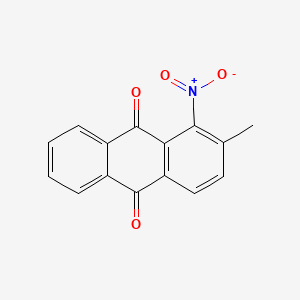D0676 | 2-methyl-1-nitroanthraquinone
| Toxicity | Dose | Time | Species | Model | Method | Action | Positive criterion | Reference |
|---|---|---|---|---|---|---|---|---|
| MEMBRANE POTENTIAL | 1.34±0.15 | human | qHTS-HepG2 | MMP assay | decrease | IC50 | 163 | |
| MEMBRANE POTENTIAL | 2.77 | human | HepG2 | MMP assay | decrease | IC50 | 163 | |
| MEMBRANE POTENTIAL | 16.95±14.73 | rat | hepatocytes | MMP assay | decrease | IC50 | 163 | |
| Pictogram | Signal | Statements | Precautionary Statement Codes |
|---|---|---|---|
 |
Warning |
Aggregated GHS information provided by 38 companies from 1 notifications to the ECHA C&L Inventory. H351 (100%): Suspected of causing cancer [Warning Carcinogenicity] Information may vary between notifications depending on impurities, additives, and other factors. The percentage value in parenthesis indicates the notified classification ratio from companies that provide hazard codes. Only hazard codes with percentage values above 10% are shown. |
P201, P202, P281, P308+P313, P405, and P501; (The corresponding statement to each P-code can be found at the GHS Classification page.) |
 |
Warning |
H351: Suspected of causing cancer [Warning Carcinogenicity] H373: Causes damage to organs through prolonged or repeated exposure [Warning Specific target organ toxicity, repeated exposure] |
P201, P202, P260, P281, P308+P313, P314, P405, and P501; (The corresponding statement to each P-code can be found at the GHS Classification page.) |
 |
Warning |
H351: Suspected of causing cancer [Warning Carcinogenicity] H373: Causes damage to organs through prolonged or repeated exposure [Warning Specific target organ toxicity, repeated exposure] |
P201, P202, P260, P281, P308+P313, P314, P405, and P501; (The corresponding statement to each P-code can be found at the GHS Classification page.) |
| 1-N-2-MA [Russian] | 1-N-2-Ma | 1-Nitro-2-methylanthraquinone |
| 129-15-7 | 2-METHYL-1-NITRO-9,10-DIHYDROANTHRACENE-9,10-DIONE; | 2-METHYL-1-NITROANTHRAQUINONE |
| 2-Methyl-1-nitro-9,10-anthracenedione | 2-Methyl-1-nitroanthra-9,10-quinone | 2-Methyl-1-nitroanthra-9,10-quinone # |
| 2-Methyl-1-nitroanthraquinone (of uncertain purity) | 2-Methyl-1-nitroanthraquinone (uncertain purity) | 2-methyl-1-nitro-9,10-anthraquinone |
| 2-methyl-1-nitro-anthracene-9,10-dione | 2-methyl-1-nitroanthracene-9,10-dione | 4-07-00-02576 (Beilstein Handbook Reference) |
| 9, 2-methyl-1-nitro- | 9,10-Anthracenedione, 2-methyl-1-nitro- | 9,10-Anthracenedione,2-methyl-1-nitro- |
| A805915 | AI3-14928 | AKOS001574453 |
| Anthraquinone, 2-methyl-1-nitro- | BBL034672 | BRN 2140943 |
| C19264 | CAS-129-15-7 | CCRIS 397 |
| CHEBI:82345 | CHEMBL1331312 | CTK4B6181 |
| DSSTox_CID_847 | DSSTox_GSID_20847 | DSSTox_RID_75826 |
| DTXSID7020847 | EINECS 204-932-0 | FT-0612906 |
| FYXKXZFTZBYYNP-UHFFFAOYSA-N | HSDB 6193 | LS-720 |
| MCULE-8127254291 | NCGC00091877-01 | NCGC00091877-02 |
| NCGC00260023-01 | NCI-C01923 | NSC 8 |
| NSC-8 | NSC8 | Q27155888 |
| SCHEMBL3276062 | ST50488267 | STL428857 |
| TRA0070644 | Tox21_202474 | UNII-XU83BY176P |
| VS-12635 | Violet Cibacet 2R | W-109474 |
| WLN: L C666 BV IVJ DNW E1 | XU83BY176P | ZINC3844571 |

